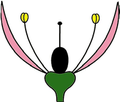Perianth

1. flower base (Receptakulum)
2. sepals (sepals)
3 petals (petals)
4. stamens (stamens)
5. stamp (pestle)
The perianth or perianth is the totality of sterile leaf organs in the flower of angiosperms . It sits below or outside. The function of the perianth is to protect the fertile organs in the bud stage and to attract pollinators during anthesis .
to form
A flower envelope that is divided into the mostly green calyx (calyx) and the mostly colored crown (corolla) ( double perianth ; dichlamydeic) (biseriat) is referred to as non-uniform or heterochlamydeic . A perianth that is not divided into a calyx and a crown is called uniform. The simple perianth consists of several similar members - the tepals - and is also known as a perigon . It can be single-circle (mono-, haplochlamydeic) (uniseriat) or two- (dichlamydeic) (biseriat) or multi-circle, the multiple perigon (pseudoperigon), it is homoiochlamydeic in both cases.
If either the petals or sepals are completely absent, the simple perianth can be described as mono- or haplochlamydeic.
If the flower cover is missing, as is the case with the common ash ( Fraxinus excelsior ), the flower is referred to as naked or apo, achlamydeic.
The members of the flower cover can be fused together. This is called Sym- or Gamotepalie for the perigon , Sym- or Gamosepalie for the chalice, Sym- or Gamopetalie for the crown . If the individual leaves are not grown together, this is called apo- or choritepal, -sepal, -petal .
An additional outer calyx (epicalyx) can also be present.
Historical
The term perianth was first used by Jungius in 1678. Like Ray 1682 and Linné 1751, he used perianth for the chalice. The crown was then considered to be the actual flower. Perianth in today's sense has only been used for the entire flower cover since Mirbel in 1815.
See also
- Petal
- Minor crown or minor perigone, paracorolla
literature
- Adolf Engler : Syllabus of lectures on special and medicinisch-pharmaceutische botany. 4th revised edition, Borntraeger, 1904, p. XV, XXVIII ( archive.org ).
- Focko Weberling : Morphology of Flowers and Inflorescences. Cambridge Univ. Press, 1992, ISBN 0-521-25134-6 .
- Ernst Gilg , PN Schürhoff: Basic features of botany. 7th edition, Springer, 1931, ISBN 978-3-642-89447-3 (reprint), p. 18 f.
- Richard Wettstein : Handbook of Systematic Botany. 3rd revised edition, Deuticke, 1924, p. 475 f. ( archive.org ).
Web links
Individual evidence
- ^ Andreas Bresinsky , Christian Körner , Joachim W. Kadereit , Gunther Neuhaus , Uwe Sonnewald : Textbook of Botany . Founded by Eduard Strasburger . 36th edition. Spektrum Akademischer Verlag, Heidelberg 2008, ISBN 978-3-8274-1455-7 , p. 803-804 .
- ^ A b c Manfred A. Fischer , Karl Oswald, Wolfgang Adler: Excursion flora for Austria, Liechtenstein and South Tyrol. 3rd, improved edition. Province of Upper Austria, Biology Center of the Upper Austrian State Museums, Linz 2008, ISBN 978-3-85474-187-9 , p. 93 f.
- ^ Gerhard Wagenitz : Dictionary of Botany. Morphology, anatomy, taxonomy, evolution. With English-German and French-German registers . 2nd expanded edition. Nikol, Hamburg 2008, ISBN 978-3-937872-94-0 , pp. 236 (licensed edition 2003).



